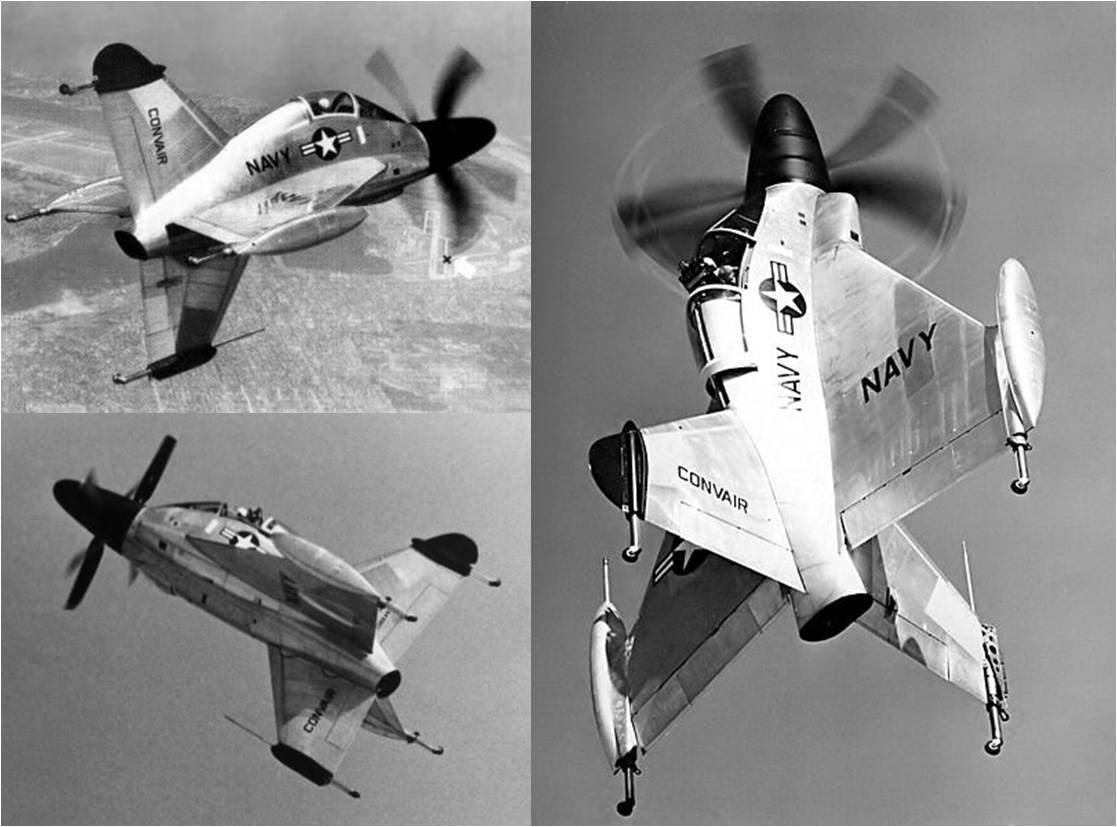Fifty-six years ago this week, the USN/Convair XFY-1 became the first Vertical Take-Off and Landing (VTOL) aircraft to successfully transition from vertical to horizontal flight. The historic flight was piloted by famed Convair engineering test pilot James F. “Skeets” Coleman.
Motivated by World War II lessons-learned, the United States Navy began contemplating the feasibility of using VTOL aircraft for fleet defense in 1947. A VTOL aircraft would combine the vertical take-off and landing capabilities of a helicopter with the speed and agility of a fighter. The operational advantage and flexibility derived from basing such an aircraft on non-aircraft carrier naval vessels were powerful allurements indeed.
In May of 1951, the Navy awarded contracts to Lockheed and Convair to develop and flight test an experimental VTOL aircraft. The Lockheed offering was designated as the XFV-1 while Convair’s version became known as the XFY-1. Both companies were to produce two (2) test aircraft each. History records that each company would ultimately produce just a single copy of its respective prototype.
Convair nicknamed its VTOL aircraft Pogo after the Pogo Stick jumping toy popularized by an earlier generation of American youth. Such appellation referred to the XFY-1’s tendency to bounce on its quartet of shock-absorbered landing gear at touchdown. The similarity to one bouncing up and down on a spring-loaded Pogo Stick is obvious.
The XFY-1 Pogo measured 35 feet in length and had a wing span of nearly 29 feet. The type had a GTOW of 16,250 lbs and an empty weight of 11,750 lbs. Power was provided by a 5,500 hp Allison YT-40 turboprop which drove twin, 3-blade, 16-foot diameter contra-rotating propellers. This propulsion system produced a maximum thrust of 17,000 lbs.
The Pogo was difficult to fly vertically in close proximity to the ground. Prop-wash interaction with the aircraft and ground plane being the chief culprit. Even more difficult was the transition from vertical to horizontal flight and back again. It was particularly challenging to land the aircraft as the pilot had to look over his shoulder and “back down” to a landing.
The XFY-1 pilot sat in a seat that rotated to accommodate vertical and horizontal flight attitudes as appropriate. Pilot cockpit entry was via a 25-foot auxiliary ladder. Interestingly, the pilot was provided with a 25-foot rope for emergency egress during ground operations.
James F. “Skeets” Coleman was Convair’s project test pilot for XFY-1 flight tests. Coleman began tethered flight testing of the aircraft on Thursday, 29 April 1954 at NAS Moffett Field, California. Roughly 60 hours of tethered-flight testing took place within Moffett’s cavernous Hanger Number One. With a ceiling height of 195 feet, the building provided ample room for initial XFY-1 vertical flight testing.
On Sunday, 01 August 1954, Coleman made the first untethered XFY-1 flight test in the vertical. Following several more successful vertical take-off and landing trials, XFY-1 flight test activities were transferred to NAS Brown Field near San Diego, California. There, Coleman intently practiced (making 70 flights overall) in anticipation of the first attempt to transition the XFY-1 from vertical to horizontal flight.
On Tuesday, 02 November 1954, with Skeets Coleman at the controls, the XFY-1 lifted-off in the vertical from Brown Field. Coleman then carefully and skillfully transitioned the XFY-1 to horizontal flight for the first time. In 21 minutes of horizontal flight, Coleman put the nimble XFY-1 through its paces. The Pogo’s big Allison turboprop had power to spare as Coleman hit airspeeds well in excess of 300 mph.
When it was finally time to land the XFY-1, Coleman made a low altitude, minimum power approach and pulled into the vertical. As the aircraft quickly ascended, the airspeed bled-off just as rapidly. Near the top of the climb, Coleman advanced the throttle. The XFY-1 hung in the cool autumn air on the thrust of its twin props alone. The pilot then carefully descended from about 1,000 feet AGL and landed uneventfully.
Skeets Coleman made many more flights in which he demonstrated the Pogo’s VTOL capabilities. However, USN interest in the VTOL concept in general and the XFY-1 aircraft in particular began to wane. While the XFY-1 had indeed demonstrated the feasibility of VTOL flight, it also revealed the operational impracticality of such given the technology of the time.
The Achilles Heel of the Convair XFY-1 VTOL aircraft was the vertical landing phase. The pilot just could not judge rate-of-descent accurately. This was attributed partly to the fact that he had to look over his shoulder throughout the descent. In addition, XFY-1 throttle-induced lateral-directional handling qualities were poor and forced the pilot to work very hard at landing the aircraft even in low-wind conditions.
Skeets Coleman made the last flight of the XFY-1 experimental aircraft on Thursday, 16 June 1955. For his significant piloting efforts in successfully demonstrating the feasibility of the VTOL concept, he received the 1954 Harmon Trophy. The lone Convair XFY-1 Pogo test aircraft survived the flight test program and is currently held in the historical collection of the National Air and Space Museum.


Comments
I WAS IN CRASH CREW THAT STOOD BY ON THAT HISTORICAL DAY.I TALK TO MR COLEMANS SON MARTY ONCE IN AWHILE ON PHONE.I AM 75 YEARS OF AGE NOW AND WAS 18 AT TIME THIS HAPPENED. THANKS FOR THE MEMORIES.ED HESS
Share this post: